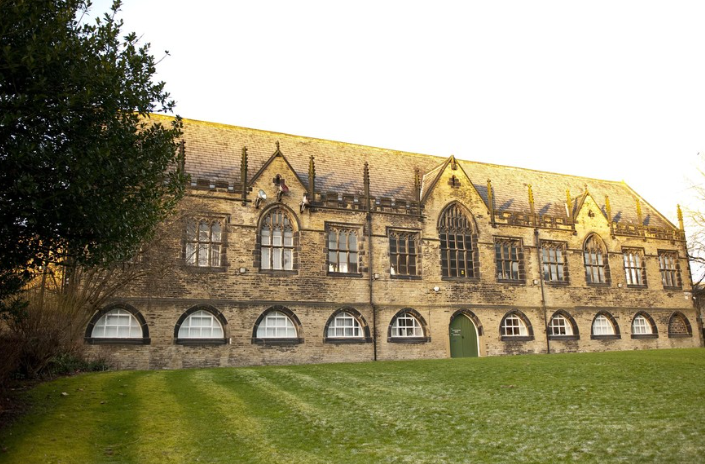The Guild at Causey Hall, which is anchored next to Halifax Minster, is being carefully redesigned as a creative hub that links the past with bright futures. The building, which was first built in 1857 as a parish school, is currently transforming into a dynamic space for public expression. Halifax, a town recently energized by cultural investment and artistic revival, benefits most from this reactivation.

The Creative Learning Guild has secured a space that serves both modernity and memory through their partnership with Bamford Developments Limited. The project aims to revitalize public engagement through arts-led regeneration rather than just focusing on physical assets. It signifies a return to education in an environment influenced by many generations of kids, families, and educators.
Key Facts – The Guild Causey Hall
| Attribute | Details |
|---|---|
| Location | Causey Hall, beside Halifax Minster, West Yorkshire |
| Project Partner | Creative Learning Guild in collaboration with Bamford Developments Limited |
| Original Function | Built in 1857 as a parish school |
| Reopening Purpose | Hub for creative learning, events, and inclusive community engagement |
| Architectural Partner | Gargarin Architects with focus on accessibility and flexible use |
| Launch Goal | September/October 2018 |
| Accessibility Planning | Partnership with Calderdale Council’s Disabled Children’s Team through Short Breaks scheme |
| Website |
The Guild’s Managing Director, Gilly Bryerley, articulated a very clear vision: every element of the renovated area should stimulate creativity in both adults and children. Her leadership exemplifies the notion that creativity is an essential aspect of life, just as important as friendship, food, and shelter, rather than a luxury.
This philosophy has been translated by Gargarin architects into a design that is significantly better than its previous arrangement. A main hall, flexible meeting rooms, and fully accessible offices are all part of their plan. They are making sure that The Guild is for everyone by incorporating inclusive planning from the beginning.
The accessibility blueprint has benefited greatly from the Short Breaks programme, which was developed in consultation with the Disabled Children’s Team of Calderdale Council. That approach is incredibly successful in meeting needs before they become constraints. The entire environment is extremely effective for a variety of users thanks to the design of the spaces, which includes discrete ramps, inconspicuous supports, and tools for spatial orientation.
The hall will be open to the public in addition to its internal goal of fostering creativity. Access to host events, conduct workshops, and hold conferences will be extended to community organizations, business owners, and independent artists. This type of accessibility transforms Causey Hall from a static space into a dynamic, adaptable, and hospitable living organism.
The location has historically been associated with the diverse rural landscapes of Yorkshire. The ruins of ‘Short Rigends’ can still be seen just below the railway crossing. Originally extending toward the Causey Arch structure, these ridged fields were used for farming in the seventeenth century. The history of the hall is based on farming and education, two very social pursuits.
The building underwent minor alterations in the early 20th century, including the installation of a flush toilet in the 1920s and the replacement of the pan tiles with a slate roof. The Claveringe Estate owned it, not a brewery, and the tenant had complete control over the beer selection. A layer of lived memory is added by the accounts of former occupants such as Douglas and Nora Watson, who moved in in 1930. Douglas, who was famously employed at Andrews House Farm prior to traveling for Jimmy Deuchers, personified a working-class tenacity that still reverberates throughout the structure.
Today, creativity is being used to reinterpret that resilience. The Guild at Causey Hall is becoming a highly adaptable model of education and civic pride by providing inclusive programming, opportunities for skill development, and an emotionally engaging environment. It is part of a larger trend in the UK where old buildings are being imaginatively repurposed to meet modern demands.
Similar initiatives are being led by organizations like London’s Battersea Arts Centre and Manchester’s HOME. Old theaters, fire stations, and even churches are converted into hybrid spaces that blend social inclusion, business incubation, and cultural performances. The Guild at Causey Hall has a local intimacy that makes it incredibly valuable, even though its goals are remarkably similar.
The Guild has gained momentum and space through strategic partnerships like the one with Bamford Developments. These connections show a common understanding that economic sustainability and artistic expression can and should coexist. Public funding for these initiatives benefits civic engagement, mental health, and educational advancement.
As the building gets closer to completion in the upcoming months, the neighborhood will start to feel its presence both physically and emotionally. Halifax’s creative pulse will be linked to its historical heartbeat through the daily rituals of children laughing, paint splashing, musicians practicing, and poets writing.
Towns like Halifax have been characterized as culturally dormant ever since industrial manufacturing declined. However, places like The Guild Causey Hall sharply contradict that narrative. They encourage a new generation of makers and thinkers by inviting participation from people of all ages and backgrounds. Instead of forcing itself on the community, the hall listens before taking action.
